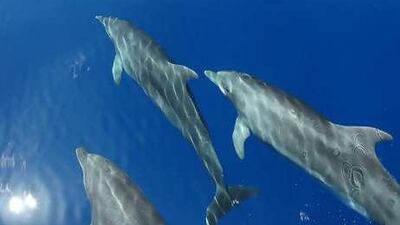Once the world's greatest underwater pearl mine, the ridge known as the Great Pearl Bank Barrier supplied divers inhabiting Abu Dhabi's coast with riches long before crude oil awakened the emirate. Pearls were the lifeblood of the Gulf, and the Great Pearl Bank Barrier, which extends along the southwest side, was abundant in valuable Black-lip oyster beds. "It's an area that was just legendary for large-sized pearls," explained Dr Mark Beech, who has conducted research for the Abu Dhabi Islands Archaeological Survey (ADIAS).
"It was a very concentrated area where there were particularly good pearl areas and all sorts of pearl beds." Most common were the pearl species Pinctada margaritifera and Pinctada radiata, which were precious for jewellery and toolmaking, Dr Beech said. But they have since depleted in population because of overfishing and foreign demand. The Great Pearl Bank's shallow waters (10 metres in depth) attracted rich deposits of calcium carbonate, accumulating within oysters to fold into the round gems.
Reef development was also ideal in the submarine ridge, as corals thrive closer to the sea surface in turbid waters. The Great Pearl Bank Barrier in the eastern part of Abu Dhabi shaped the marine environment by protecting inshore waters from prevailing winds near Marawah island. Pottery fragments found on Delma Island indicate that seafaring, coastal-based settlers inhabiting the area some 7,000 years ago in the late Stone Age depended on the resources of that coastal zone.
Dr Walid Yasin, the manager of archaeology for the Abu Dhabi Authority for Culture and Heritage, said ancient societies had inhabited Marawah and Delma islands since the 5th millennium BC. "Of course Abu Dhabi tribes have been living on the coast for centuries, diving for pearls there," he said. "There were fishing communities living on marine resources living around the coast from Ras al Khaimah to Abu Dhabi and a bit further west, consuming dugongs."
Neil Mallen, the environmental planning manager for the Urban Planning Council, said geologists and biologists have written about the Great Pearl Bank Barrier for years, "but people just haven't heard of this in the public arena." He characterised the area as "roughly analogous" to Australia's Great Barrier Reef, though not as large (the total area of Abu Dhabi's marine territorial water is 37,717 square km and includes about 50 islands; the Great Barrier Reef is about 344,400 square km).
According to the 2004 Marine Atlas Abu Dhabi, the area is richer in the number of coral species than the entire Caribbean. The shallow shelf's rocky outcrops also prevent high-energy waves from reaching the shoreline, which creates a lagoon environment with a very high natural biological diversity. Green and hawksbill turtles have been known to forage and nest in the reef habitat around Marawah and Dabb'iya islands in western Abu Dhabi.
"The system that we're talking about is so rich that it actually supports a resident population of killer whales," Mr Mallen said. Indeed, several Emirati fishermen spotted seven killer whales swimming off the coast of the capital in June, and were even able to capture the mammals on film for the first time. As killer whales are known to be top predators that hunt marine animals, including sea lions and seals, their presence in the Gulf waters carries implications about the subtropical ecosystem.
"The significance of that is they can only exist if there's a rich and diverse marine food web that supports that top predator," Mr Mallen said. Vegetation such as seagrass meadows and mangroves would sit at the bottom of the food chain, supporting large populations of fish species as well as coral reef. "And then you get up into things like sea turtles, sea snakes, sea birds, dolphins and of course dugongs," Mr Mallen said.
Also known as "sea cows", the large grey marine mammals thrive in the Gulf. According to the 2004 Marine Atlas Abu Dhabi, the area is home to "the largest known population" of dugongs outside Australia, with the Great Pearl Bank Barrier on Abu Dhabi's side representing half the Gulf population. Their population is attributed to the vast seagrass meadows near the emirate. Research teams for the marine atlas reported sightings within a few kilometres of Abu Dhabi City, with 72 per cent of all dugongs and 55 per cent of all green turtles and dolphins sighted within a 45-kilometre radius of Marawah island, which lies 100 kilometres to the west of the city.
This dugong population was estimated at 2,691 in 1999, but their numbers were in steady decline. That same year, it became illegal to hunt the mammals in Abu Dhabi, as the dugongs are listed internationally as "vulnerable to extinction". Bottlenose and Indo-Pacific humpback dolphins are also among the 11 species of dolphins and porpoise, but they, too, have declined dramatically in recent years. Oil concession areas have cut through the Great Pearl Bank Barrier over time, meaning conservation efforts are now essential to restoring the Gulf as a habitat for dugongs and other rare or endangered species.
A marine reserve at Marawah, which sits off the coast of the small Western Region town of Al Marfa, protects some of the biological diversity, Mr Mallen said. But environmental scientists with the Abu Dhabi Heritage Club have said more must be done to protect Abu Dhabi's reefs from modern infrastructure. Climate change and the rising summer seawater temperatures are also considered to be primary causes of coral death.
Until recently, very little ecological data has been collected and published relating to the marine environment, but preserving the coastal zone can be considered integral to telling the history of the nation. As Mr Mallen noted, the coast is an essential part of the UAE's cultural heritage. "An early civilization survived and thrived on the Great Pearl Bank," he said. "The two go hand-in-hand. There wouldn't have been a civilization here if there weren't resources to support it."
@email:mkwong@thenational.ae

